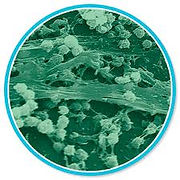Biofilm Control

Jump Ahead Menu
Biofilm are widely recognised as sources of a persistent wound infection that are tolerant to antibiotics, antiseptics and the host immune system.
Manual debridement is the cornerstone of biofilm removal
In addition, there is now published consensus that augmenting manual strategies with a solution such as those containing hypochlorous acid to enhance debridement outcomes in replacement of passive solutions such as saline or water may be vital for improving the management of wounds with a high bacterial load such as chronic wounds.
Biofilm are not visible to the naked eye necessitating treatment approaches proven to disrupt them and achieve wound healing. Let's assess the evidence.
Biofilm-Based Wound Care
International Consensus Document 2020: Defying Hard-to-Heal Wounds - Wound Hygiene.
Murphy et al JWC Journal of Wound Care 2020 S1 - 28.
It is widely accepted now that hard-to-heal and chronic wounds are colonised by a complex microbial community that can adhere to the bed termed a biofilm.
The biofilm causes a sustained, sub-clinical wound infection that perpetuates the inflammatory response and can be tolerant to antibiotics and host immunity. Biofilm-based wound care (BBWC) is intended to challenge the hindrance this microbial colony may illicit on normal wound healing.
We must use evidence-based technologies and modalities to reduce the burden caused by biofilm.
So what evidence is there?

Biofilm cycle extracted from: Murphy et al JWC Journal of Wound Care 2020 S1 - 28.
International Consensus Highlights
-
"Saline or water will not remove biofilm"
-
"The evidence on the ability of surfactants to remove wound biofilm is low and mainly in vitro"
-
"Highly cytotoxic preparations such as povidone-iodine or peroxide are not recommended."
During the routine cleansing of hard-to-heal wounds, it is essential to undertake good wound hygiene, analogous to good oral hygiene, using an adjunctive solution to aid decontamination during manual cleaning or debridement. The 2020 consensus document of defying hard to heal wounds includes hypochlorous acid as an agent possessing some traits that may considered ideal;
Clinical Trials

-
"Rapid-onset"
-
"Low cytotoxicity"
-
"Broad-spectrum antimicrobial effect"
-
"Effective for loosening dressings as well as cleaning"
As a leading formulation containing pH neutral hypochlorous acid, Microdacyn represents and an ideal improvement on normal saline in the routine cleansing of hard-to-heal wounds.
Effect on Biofilm
Guidelines
The latest clinical practice guidelines published by the international wound infection institute cite super-oxidized hypochlorous acid and hypochlorite (Microdacyn) with the ability to;
"penetrate biofilms rapidly, killing formations from within"

Comparing Wound Treatments: Biofilm Reductions
Further research by Johani et al in 2017 reported only three of their test products were able to effect a statistically significant reduction of both gram-negative and gram-positive biofilms within 15 minutes of exposure in vitro.
-
SOS - Super-oxidised solution (Microdacyn)
-
Povidone-Iodine 10%
-
Chlorhexidine 0.05% + Cetrimide 0.15%
Other test products included a surfactant-based polyhexanide solution SB-PHMB (Prontosan) and a melaleuca oil-containing gel both failed to reduce S aureus counts with any significance with the same exposure time.


Visualising the Penetration of Biofilms
Research by Sauer and co used LIVE/DEAD staining of Pseudomonas arigonsia biofilms to visualise the effect Microdacyn had before and after repeated exposure in vitro.
Their findings report a significant reduction in bacterial load in a clinically relevant time-frame.
Extracts from their publication are shown below allowing us to visualise the outcomes achieved by Microdacyn when used to physically reduce biofilm-based microbes
Have confidence in cleansing with Microdacyn to ensure effective and non-cytotoxic reductions of biofilm curing routine found cleansing
Microdacyn rapidly penetrates biofilms killing microbes within.
-
Microdacyn causes disaggregation of the biofilm structure making it less adherent and more easily removed
-
Finally, Microdacyn physically reduces the biofilm matrix while reducing the internal microbial colonies.
Visual Confirmation
Below shows fluorescence spectroscopy of a mature Pseudomonas arganosoia biofilm before the addition of Microdacyn
Under fluorescence:
living microbes appear Green & Dead microbes appear Red
You can easily see the whole biofilm-cluster is illuminated bright green indicating a living microbial colony within
time = 0 minutes

Post Application: Biofilm
Now compare the fluorescence spectroscopy of the same Pseudomonas arganosoia biofilm after the continued exposure to Microdacyn for 10 minutes
You can easily see the cluster has been uniformly penetrated through all axis whereby the green has turned red indicating the majority of living microbes have now been reduced
time = 10 minutes

